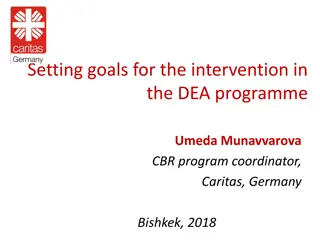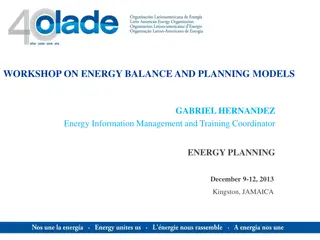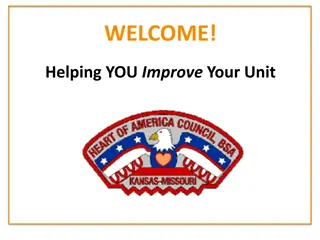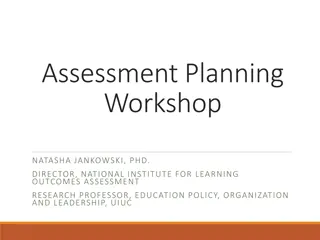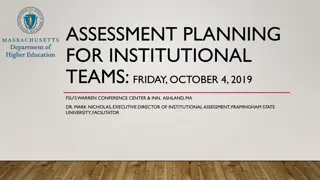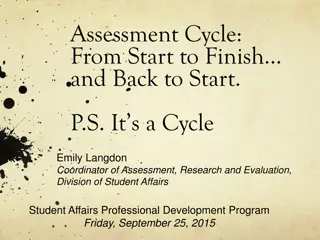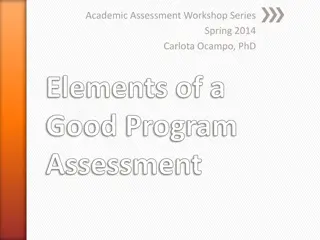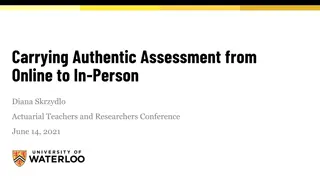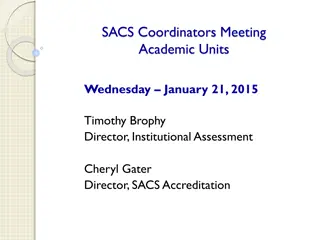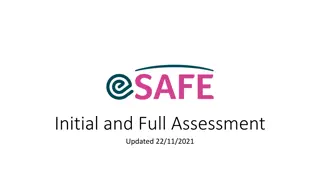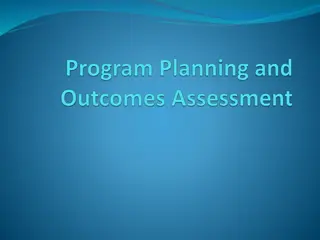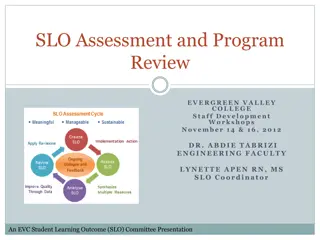Effective Program Assessment Planning Guide
Program assessment is a continuous process ensuring student learning outcomes are met. It involves setting clear objectives, gathering evidence, analyzing results, and making improvements. This comprehensive guide covers key steps in assessment planning, emphasizing the importance of data-driven decision-making and meeting accreditation requirements.
Download Presentation

Please find below an Image/Link to download the presentation.
The content on the website is provided AS IS for your information and personal use only. It may not be sold, licensed, or shared on other websites without obtaining consent from the author.If you encounter any issues during the download, it is possible that the publisher has removed the file from their server.
You are allowed to download the files provided on this website for personal or commercial use, subject to the condition that they are used lawfully. All files are the property of their respective owners.
The content on the website is provided AS IS for your information and personal use only. It may not be sold, licensed, or shared on other websites without obtaining consent from the author.
E N D
Presentation Transcript
ASSESSMENT PLANNING: Create a program assessment plan that is meaningful, manageable, and sustainable
First: what is assessment? Academic program assessment is an ongoing process of collecting and analyzing information in order to determine how well student outcomes are being met. The ultimate goals are to: 1) ensure that students are learning what you want them to learn in your program, and 2) find areas where things may need to be adjusted in instruction in order to improve student learning To help meet those goals, assessment involves: setting clear, measurable objectives for student learning collecting evidence to determine how well those objectives are being met use that information to improve the program (close the loop)
The process Step 1: Identify learning outcomes clearly define what students should know, be able to do, or value by the end of the program. Ask yourself: what should a student majoring in my program know or be able to do by the time they graduate (that they didn t pick up from the general education curriculum)? These outcomes are commonly called SLOs (Student Learning Outcomes) Step 2: Gather evidence identify targets for each SLO and collect data and other evidence that indicates to what extent your students are reaching those outcomes. Targets may be things like rubric scores on a specific paper, proficiency grades on a standardized exam, survey responses, level of mastery demonstrated in portfolios, etc. Targets are typically expressed in terms of what percentage of students should achieve a certain level (e.g., At least half of our students should achieve a score 4/5 or better on the rubric.
The process (cont.) Step 3: Analyze results evaluate the extent to which students are meeting your outcomes. Keep notes, as necessary, to help with interpretation. Step 4: Revise or improve, where necessary use results to revise and improve your outcomes, methods, and program components. The Analysis Questions, at the end of the report form, can help with this
Okay, but why do we do this? Helps us understand and improve student learning. Provides data-driven evidence of effectiveness. Informs curricular decisions. Facilitates resource allocation. Engages the community. Highlights program-specific contributions to student growth. Creates a shared vision and collective ownership in the program.
Also, lets be honest: we kinda have to SACSCOC: The Southern Association of Colleges and Schools Commission (commonly referred to simply as SACS). Our accrediting body. Complete expectations can be found in their document Principles of Accreditation, Section 8.2, but in a nutshell, they want to know: Are expected student learning outcomes clearly defined in measurable terms for each program? How do you determine whether these outcomes are met? How are the results of assessment activities analyzed? How have programs improved as a result of the assessment findings? Note how these map on to the steps of our assessment program (slides 3-4)
The program mission statement We ask that every program develop (and revise, as needed) a program mission statement as part of it s assessment plan. The mission statement serves a few different functions: 1.) Articulates a guiding framework and overarching purpose of the program. This might include values, goals, objectives, intent, etc. 2.) States how the program aligns with broader mission of the institution. 3.) Serves as a reference point (or basis) for assessment. 4.) Facilitates cohesion and unity of purpose within the program.
An example mission statement (credit to UConn IRE for this image)
Assessment at RC Currently (AY 2023-24), we re in the middle of switching from a one-year assessment plan approach to a 3-year assessment plan approach This adjustment was made for a couple reasons: 1.) to ensure that report feedback was timely and relevant. 2.) so that programs had time to gather more data during a single cycle. 3.) to encourage more creative, meaningful improvements/adjustments. Details about the cycle and all sorts of goodies can be found on the RC Assess Digication page (https://roanoke.digication.com/assess/home) Calendar! Forms! Past reports!
Assessment at RC (cont.) APAC (the Academic Program Assessment Committee) regularly reviews the assessment reports from each program and provides feedback, thoughts, and questions to consider. On our 3-year cycle, programs: Collect and record data every year. Have a brief check-in with APAC at the end of the 2ndyear. Submit the full assessment at the end of the 3rdyear. APAC works to provide feedback in a timely manner so that programs can quickly make adjustments to their assessment plans, if needed.
Assessment at RC (cont.) Programs should aim for 5-8 Student Learning Outcomes (SLOs) These outcomes should align with the program s mission. Each outcome should have 2-3 measures, each with its own specified target Where it makes sense, use both direct and indirect measures. Direct measures provide concrete evidence of student learning. For example, one of your measures may be scores on a quiz about proper use of lab equipment. Your target may be something like at least of the students will score at or above 80%. Indirect measures gauges students perceptions, reflections, or other signs that they are learning. For example, you may have an exit survey that asks students how confident they are that they know how to use specific laboratory equipment safely, with a target that all students feel at least moderately confident . Note that some programs, like education and business, have additional accreditation requirements
How do I write a good SLO? Student learning outcomes: Identify specific behaviors, knowledge, skills, etc. that students should be able to demonstrate as a result of participating in the program Focuses on what you want your students to know or be able to do Go back to the question what should a student majoring in my program know or be able to do by the time they graduate (that they didn t pick up from the general education curriculum)? Try to track each SLO in different places (for instance, in both a 200 and 400 level course, or across different sections). Be sure to adjust expectations to be appropriate to the level.
How do I identify measures? Identify what stand-alone, observable behaviors/outcomes provide evidence of that learning, then figure out how to measure it. Be mindful of the words you choose in your SLOs: Choose words that signify something measurable. An SLO that says something like students should know the major theories of psychology can be hard to measure and is unclear. Students should be able to discuss major theories of psychology provides a clearer, more measurable goal.
Image credit: University of Wisconsin-Madison, Continuing Studies
How do I identify targets? There are two things to think about when identifying a target for your measures: 1.) Is the target appropriate to the level? You wouldn t expect a 200 level student to produce the quality of paper that a 400 level student should be able to produce. Adjust your target accordingly. 2.) Does the target use a valid measurement? (that is, does the target reflect the measurement?) If you want to assess whether your students can apply color theory to their own work, for example, a target that relies on participation in class may not be a valid measurement, which means any target attached to that measurement is unlikely to be giving you the information you re seeking.
Failing to hit a target Many programs are worried about failing to hit a target, and so are quite conservative in their targets. You re certainly free to take this approach, but know that failing to hit a target is okay (really!), and a rigorous (yet attainable) target can be a good challenge. If your program fails to hit a target, APAC may ask a few questions to help you think through why. For example: Was the target too difficult? Was it at too high a level for this course section, for instance? Is the measure valid? (does it truly measure what you re trying to assess?) Was this a result of a low sample size (n) and perhaps 1-2 students threw off the results? It is really no big deal to miss a target. The whole assessment process is supposed to help you think through things and improve or adjust where youdecide it s beneficial to do so.
How do I create a curriculum map? A curriculum map for assessment outlines where in the curriculum each SLO is assessed. These are very useful, and we highly recommend making one. Allows programs to align SLOs with their courses. Exposes gaps in the curriculum. Helps the program determine whether they might be able to get at more than one SLO with a single assignment/method (yes! This is possible!) Aids in course planning for the coming years. Creates an easily digestible, easy-to-read vision of assessment that s being done in the program
Curriculum map example SLO1 SLO2 SLO3 SLO4 SLO5 Course1 name Intro paper Course2 name Exam 1, HW 6 Course3 name Paper Project Course4 name Exam 2 essay Final Course5 name Reflection essay Research Exit Survey Q1 Q5
Planning for the future Assessment can help programs identify their priorities, as well as where there are areas of student instruction which need improvement. When thinking about future directions, consider: Changes in curriculum (perhaps course sequencing, for instance) Changes you might make to your assessment plan How you might implement new assignments or technologies How assessment needs might change as the expertise and interests of the faculty in the department change
For more information: Visit the RC Assess Digication page https://roanoke.digication.com/assess/home Gwen Nuss, Assessment Coordinator nuss@roanoke.edu





